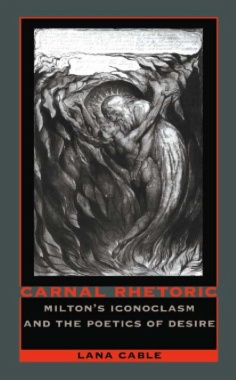In recent years, New Historicists have situated the iconoclasm of Milton’s poetry and prose within the context of political, cultural, and philosophical discourses that foreshadow early modernism. In Carnal Rhetoric, Lana Cable carries these investigations further by exploring the iconoclastic impulse in Milton’s works through detailed analyses of his use of metaphor. Building on a provocative iconoclastic theory of metaphor, she breaks new ground in the area of affective stylistics, not only as it pertains to the writings of Milton but also to all expressive language.
Cable traces the development of Milton’s iconoclastic poetics from its roots in the antiprelatical tracts, through the divorce tracts and Areopagitica, to its fullest dramatic representation in Eikonoklastes and Samson Agonistes. Arguing that, like every creative act, metaphor is by nature a radical and self-transgressing agent of change, she explores the site where metaphoric language and imaginative desire merge. Examining the demands Milton places on metaphor, particularly his emphasis on language as a vehicle for mortal redemption, Cable demonstrates the ways in which metaphor acts for him as that creative and radical agent of change. In the process, she reveals Milton’s engagement, at the deepest levels of linguistic creativity, with the early modern commitment to an imaginative and historic remaking of the world.
An insightful and synthetic book, Carnal Rhetoric will appeal to scholars of English literature, Milton, and the Renaissance, as well as to those with an interest in the theory of affective stylistics as it pertains to reader-response criticism, semantics, epistemology, and the philosophy and psychology of language.
- CONTENTS
- Acknowledgments
- Introduction
- 1 Metaphor and “Meaning”: Toward a Theory of Creative Iconoclasm
- 2 “Shuffling up such a God”: The Rhetorical Agon of Milton’s Antiprelatical Tracts
- 3 “Was she thy God?”: The Coupling Rhetoric of the Divorce Tracts
- 4 “The image of God in the eye”: Areopagitica's Truth
- 5 “Unimprisonable utterance”: Imagination and the Attack on Eikon Basilike
- 6 Samson’s Transformative Desire
- Notes
- Index

